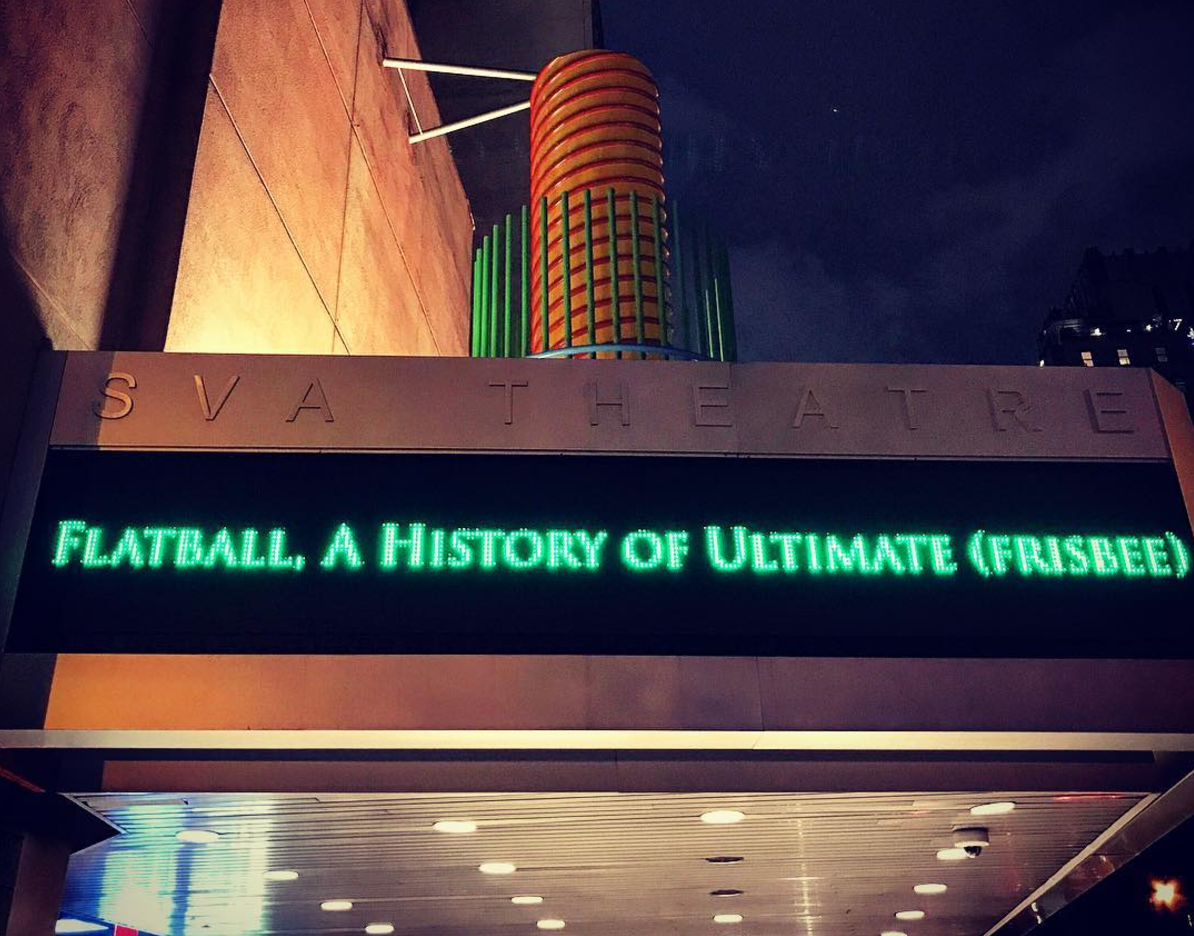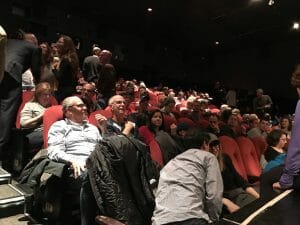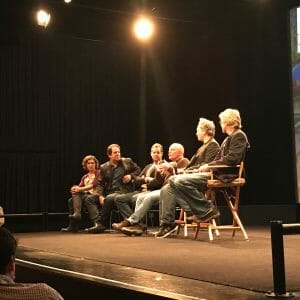Frisbee luminaries filled the seats.
December 19, 2016 by Charlie Eisenhood in News with 0 comments

NEW YORK — Nearly 30 years since the start of the New York, New York dynasty in ultimate, the team had its story told in the city where it all began.
The new documentary feature Flatball, directed by former NYNY player Dennis “Cribber” Warsen, held its New York City premiere on Sunday night in downtown Manhattan at the SVA Theatre in front of a sold out crowd of over 250 people.
Some of ultimate’s legendary figures were on hand, including the film’s star Kenny Dobyns, World Flying Disc Federation President Robert “Nob” Rauch, multiple hall of famers including the recently inducted Amy Wilbur and Randy Ricks (who flew in from Colorado), 12 players from the NYNY team, author Tony Leonardo, and sportswriter Adam Zagoria. Frisbie’s Pies were the appropriate refreshments.
Unfortunately, there would be no sighting of the film’s narrator. “According to Alec Baldwin’s team, he’s out of town. But he would really loved to have been here,” executive producer David Blau said to laughter after the screening.
Although the movie held its world premiere at the Carmel Film Festival in October, the event yesterday had the feel of the true launch. The movie is about New York ultimate at its core, and the bigger audience cheered as characters were introduced and laughed at all the right spots.
“It’s surreal,” Warsen said of showing the movie to a New York audience. “I’m liking it to the big game for me. I’ve been nervous. I haven’t been all that much fun. I’ve been barking at people.”

Flatball bills itself as a history of ultimate, but largely follows the rise and fall of New York, New York, a notorious team that won six National championships between 1987 and 1993, including five straight from ’89-’93, as well as four World titles.
To this day, the team is considered one of the greatest to ever play, but any mention of NYNY also comes with a caveat: they were ruthless. “No team was safe from the corrupting influence of these trash-talking, hard-headed miscreants who played the game like it was a blood sport,” Leonardo and Zagoria wrote in “Ultimate: The First Four Decades.”
The movie tells the story of both the dominance and, to an extent, the hard edge. Dobyns himself gave us a taste of the winning mentality in a post-screening Q&A when he was asked to recall what Ricks said was “the greatest catch [he’d] ever seen” at 1983 Nationals in New Orleans. “We lost the game,” Dobyns murmured. We never did get the story of that catch.
Although the movie also touched on other important moments in the history of ultimate — the sport’s founding at Columbia High School in 1968 (I saw a pair of high schoolers in modern CHS varsity ultimate jackets), the genesis of the NexGen tour, some big moments from the 2012 World Championships, and the development of Ultimate Peace — it was really a story of ’80s era New York.
The film’s hint at recent developments was limited to what happened before 2012. And the focus on the past bumped hard against the present when Brittany Kaplan, a player for New York’s top women’s club team Bent, posed the only critical question of the Q&A. “I work in documentary,” she said. “I’m an editor. Often what you omit from a film makes a point in itself. And I was curious about the choice to pretty much omit women’s ultimate.” The movie does tell the story of the Japanese women’s success at the 2012 World Championships, but spends the vast majority of its runtime on men’s ultimate.
“I don’t feel like I omitted women’s ultimate, but, you know…” Warsen said as the microphone was passed to Blau.

“It’s not the history of ultimate. It’s a history of ultimate,” he said before discussing the lack of available Women’s Division historical footage and the group’s plans to fund a grant from Flatball proceeds for another filmmaker to tell “a different history of ultimate.”
Mostly, though, the screening was a celebration of New York’s legacy. Dobyns, who sat in the fourth row, was seeing the movie for the second time. I asked him what it was like to be surrounded by his peers and a new generation of players, watching himself on the big screen.
“Part of what we do when we play is we kind of are acting out a movie on a daily basis on every point, every game,” he told me. “So if you’ve played at a high level, you’ve played in front of people enough, you’re kind of accustomed to sort of baring your soul. Honestly, that’s more comfortable than sitting in a seat doing it.
“So I would say if I get the choice I would rather be on a field. It’s a little hard, and there’s some parts in this that are pretty emotional. I’ve seen it twice and I haven’t gotten through that part yet. Maybe third time around I’ll get through it. I’ll give Dennis credit: it’s an honest portrait. We were a little bit over the top and it shows that, but we were also honest in our passion and I think it shows that too.”
The movie will be screened in more cities around the country in the coming months. Currently, the date for a public release is undetermined, although mid-2017 appears likely. Warsen believes that the movie will sell to audiences both inside and outside of ultimate.
“I hope it can be an important early film, like The Endless Summer was for surfing,” he said. “Just a seminal movie looking back.”
Photos by Elizabeth Fritz. A full review is forthcoming on Ultiworld upon the public release of the movie.